ISSN ONLINE(2319-8753)PRINT(2347-6710)
ISSN ONLINE(2319-8753)PRINT(2347-6710)
Milimol Philip1, Sreelatha T2, Soosan George T3
|
| Related article at Pubmed, Scholar Google |
Visit for more related articles at International Journal of Innovative Research in Science, Engineering and Technology
Mode choice behavior is a fundamental element of travel behavior that has significant implications for transportation planning and management. It is the demand for activities that produces the demand for travel. In other words the need or desire to engage in an activity at a different location generates a trip. So, once we understand how activities are engaged in the course of a day or a week, a rigorous understanding of travel demand will follow. This paper deals with the study of the travel behavior of rural middle class residents. So in this study we use the activity based approach to predict the travel behavior based on a thorough understanding of the decision process underlying travel behavior. The data for the analysis is collected using household travel survey. The study area selected is a rural village in Ernakulam district of Kerala, India. The total mode share includes walk, bicycle, auto rickshaw, two-wheeler, car and bus in which two wheelers form the major share. The data has been analyzed using Statistical Package for Social Sciences (SPSS).
Keywords |
| Activity based approach, Mode choice, SPSS, travel behavior |
INTRODUCTION |
| Since the beginning of civilization, the viability and economic success of communities have been, to a major extent, determined by the efficiency of the transportation infrastructure. However, over the past few decades, triggered by socio-economic changes, travel behaviour has changed considerably. Trip making behaviour becomes more spatially and purpose-wise complex, and hence the flexibility of travel mode becomes more important. Mobility services offered by public transport are less attractive. This has resulted in an increase in private vehicles such as car and two-wheeler ownership. India is experiencing many of the problems associated with increasing private vehicle dependence. Travel is one of many attributes of an activity. In the conventional approach, activity attributes such as the mode used and travel time consumed in accessing an activity are treated as travel attributes and are the focus of descriptive and predictive models. From this perspective, conventional trip-based models are simply a special case of activity-based approaches. Travel is essentially a physical mechanism to access an activity site for the purpose of participating in some activity. So this study is an effort to understand the mode choice behaviour of rural residents based on activity based approach. |
II. LITERATURE REVIEW |
| Activity-based approach was conceived in the 1970s by a group of researchers at Oxford University. This approach aims at the prediction of travel demand based on a thorough understanding of the decision process underlying travel behaviour. As the activities engaged in a day are linked to each other, trips made to pursue them are also linked to each other; they cannot be analysed separately one by one. Analysis of activity and travel characteristics shows the importance of mode choice in any activity-travel decision. The tendency of households to optimize their activity pattern in such a way that trips for different motives can been combined to chains has been a phenomenon of since 1970s [1]. The basic hypothesis is that a household participate in all kinds of non-home activities to meet their various needs by trips and balances the desire to meet each need as it arises with the transportation expenditures required in travel. Since travellers often chain multiple activities together in a trip chain for greater efficiency and convenience, the influence of trip chain on mode choice was considered [8] by classifying trips to single trip, simple trip chain and complex trip chain. The challenge of realistically modelling “minor” modes, while maintaining behavioural realism in the rest of the model was undertaken by simulating household interactions [6]. The relationship between mode choice and the complexity of trip chaining patterns of travel behaviour was also represented [16]. |
III. STUDY AREA |
| The rural area selected for data collection is Varappetty Panchayat which is a village in Kothamangalam Taluk of Ernakulam district in the Indian state of Kerala. It is 4.8 km distance from its Taluk main Town Kothamangalam which is known as the Gateway of High range and is 37.2 km from its District Main City Kochi 175 km from its state main city Thiruvananthapuram. |
IV. DATA COLLECTION |
| For developing the activity based mode choice model, the middle class residents of the study area are interviewed with emphasis given to previous day’s travel pattern (for the whole day) of every member of the family concerning household details, personal details and trip details. The total data set comes to of 602 (from 153 households) including both trips and non trips. Out of the 602 sample population 174(28% of total) are without any trip data. Within the remaining 427 population 120(20% of total) is with multiple trips and thereby the total data set come to 596 in number. |
V. SOCIO ECONOMIC CHARACTERISTICS |
| Fig.1 shows the mode usage in the study area. |
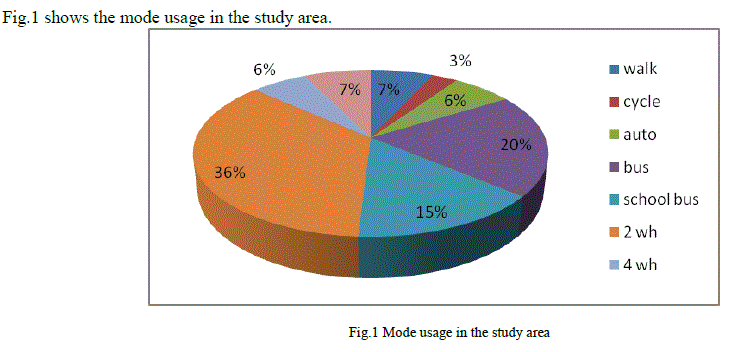 |
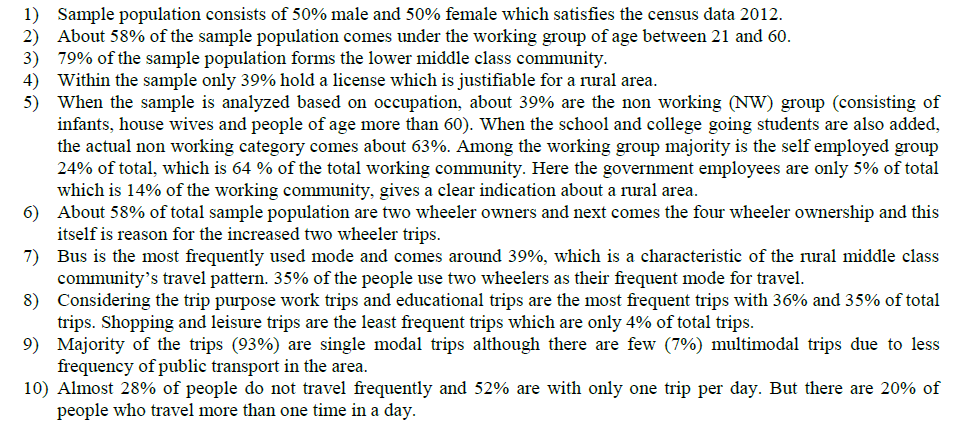 |
VI. EFFECT OF VARIABLES ON MODE CHOICE |
| From Table 1 showing the effect of household size (HHS) on mode choice it can be inferred that house hold size has no significant effect on mode choice because mostly in every mode the highest percentage is shared by household size four, which is the average household size in the rural area consisting of father, mother and two children. |
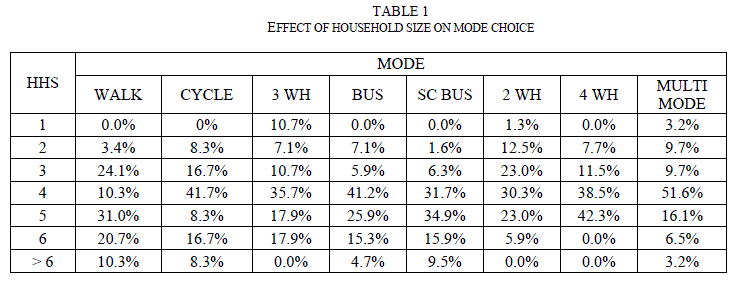 |
| Table2 shows that of people using two-wheelers, 84% are males which are a characteristic of rural area and out of those using bus, and 60% are females. Though the population consists of equal proportion of males and females, a decrease in female share is evident in each mode usage because the female population trip in lesser number than the male population which is a characteristic of the rural area. |
 |
| Majority of people using modes like walk, cycle, three-wheeler, bus and school bus are having no license, as per table3. |
 |
| Table 4 shows that there is significant effect of four-wheeler ownership on mode choice since of those choosing walk, cycle, three- wheeler or bus as their travel mode, 75% does not own a car. |
 |
| As per table 5, the effect of household annual income on mode choice is not significant. The main reason is that in developing countries, lower middle income, LMC (annual income between 2.5 to 6 lakhs) people form the majority of population in the rural areas. |
| No significant effect for number of household school children (HHSC) on mode choice as per table6 and the average number of school going children in rural families is two. |
 |
| From table 7 it is inferred that in agriculture-based rural areas the household college students (HHCL) will very rarely one or usually be zero since, people after 18 years will be going for job and is a characteristic of the rural area. |
 |
| Table 8 shows that almost all the middle class families in the rural area has got at least one two-wheeler (2 WH). |
 |
VII. EFFECT QUANTIFICATION |
| The factors which were found influencing the mode choice of rural residents were four-wheeler and three- wheeler ownership, license ownership, total trip walking time, waiting time, cost and duration. The results obtained after the multinomial logistic analysis using SPSS are given in Table 9. |
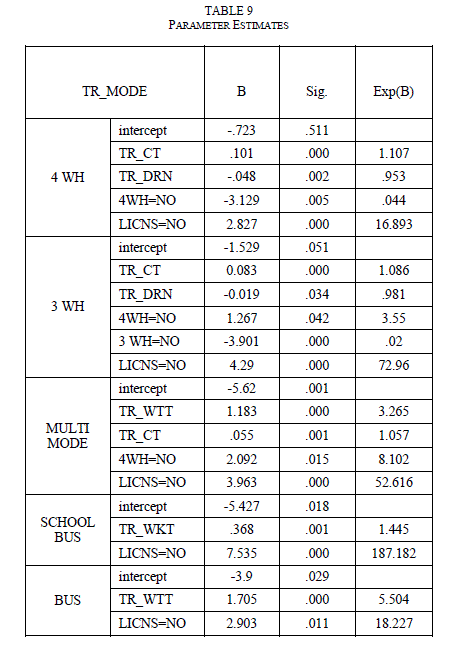 |
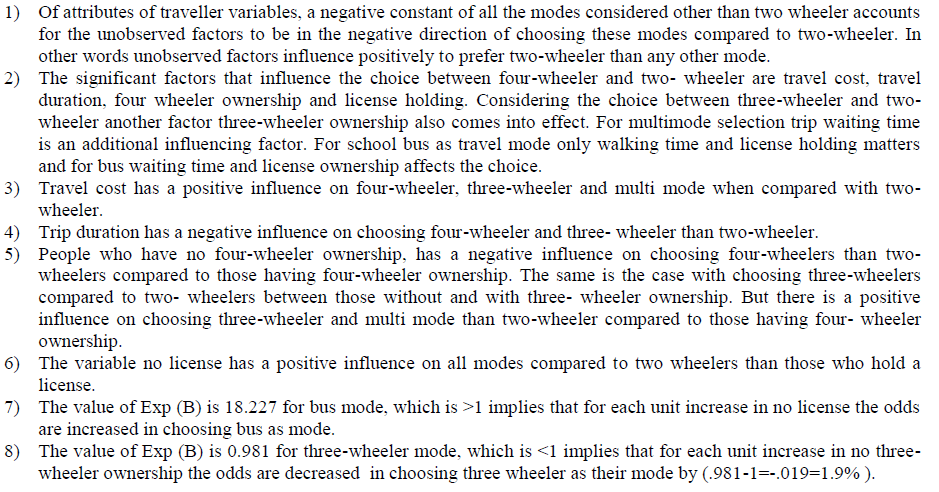 |
VIII. CONCLUSION |
| This paper is a characteristic study on the travel behaviour of rural middle class residents using activity based approach. The study helped to draw the socio economic as well as mode choice characteristics of a typical agriculture based rural village area. The activity based approach really helps to study the travel pattern in a realistic way. The empirical analysis used the data collected by means of household survey of every individual of the middle class family and software tool SPSS was used to develop the model. four-wheeler and three- wheeler ownership, license ownership, trip walking time, waiting time, cost and duration were found to be the most influencing factors for the choice of mode. The scope of the study is that it could greatly help the policy makers and will be the area of interest for public transport service providers who are interested in attracting choice riders. |
References |
|